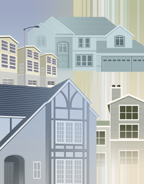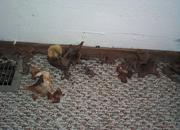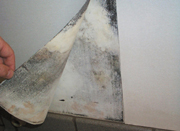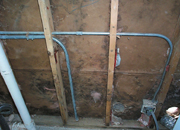

The point to remember is that toxic mold problems, though serious, are usually preventable and abatable. Most molds are not harmful, and despite the recent spate of dramatic and sometimes hysterical media accounts, the scientific data linking specific mold exposures to serious disease are actually, at this date, limited.

Why is mold a problem?
Molds are a natural and essential part of the environment, breaking down dead organic matter that is then recycled through the soil and into the food chain. Humans have co-existed comfortably with molds for most of history. Most molds have little, if any negative health impact, and most individuals have very little problem with mold exposure.Nevertheless, epidemiologists and mycologists (biologists specializing in the study of molds and fungi) now estimate that a good number of mold species-somewhere between 100 and 300 species-may potentially be injurious to human health if inhaled, ingested or in some cases even touched. Not surprisingly, the most susceptible individuals are infants, children, the elderly and those with compromised immune systems.
Why has this problem emerged today? Molds reproduce by means of tiny, usually invisible fruiting bodies, or spores, that may be carried long distances through the air. When a spore reaches a place that offers the necessities of life-moisture, food and warmth-it germinates and begins producing a branching network of cells called hyphae.
Today's mold problem has several causes. One of the most important, ironically, is the very success of the construction and homebuilding industry. Today, there are vastly more homes and buildings in the United States than ever before, and many of these have sealed, climate-controlled structures. This is especially true in areas where a hot or cold climate had kept the population fairly sparse until recent decades. As time passes, the existing housing stock ages and deteriorates, while many newer structures are constructed hastily and in some cases with inferior or untested materials. Meanwhile, advances in medical knowledge have it possible to trace more and more illnesses back to the mold pathogens and allergens that caused them. Put these factors together, and you have a recipe for a large-scale health and liability emergency.

How to handle a mold
A crew is about to start work on a building renovation when someone notices that some of the walls are slightly damp to the touch and the ceiling has some staining. What should one do?A few years ago, most contractors would simply ignore these defects. The problems-if they even were problems-were only to be expected in an older building, and in any case the offending materials would soon be in the trash heap.
Today, we have better advice: Take it seriously and deal with it. More specifically, if you want to prevent a lot of extra work, money, and potential litigation and possible damages, here are five steps to take next: stop work; investigate; quantify the results; correct the source problem; and remediate the damage.
1. Stop work
This can be very hard. Preparation, schedules, contractual obligations and-most important-happy clients all depend on the project moving forward briskly. To put all this at risk because someone suspects there may be a hidden health hazard on the premises takes more moral courage than most of us have. But we live and work in a different world today, where a slight discoloration or musty odor may be a warning signal of problems that can scuttle a project or a business. To put things in perspective, you might want to read up on the Ballard case in Texas, where a family sued for $100 million after suffering major health problems due to toxic mold. (The jury awarded them $32 million, including $12 million in punitive damages.)
2. Investigate
Look for two things: the source(s) of the moisture that nourishes the mold, and the presence, type, and extent of mold growth and damage.
Water penetration. Start by looking for sources of water or moisture. The reasoning here is simple: Mold needs water. No water, no mold. And conversely, find the water problem and you will find the mold.
Look everywhere you might find water, including leaks from outside or from interior water sources and areas where cold surfaces may have caused condensation. Be sure to cover the following:
o The "high spots," such as roofs and attics, especially near dormers and valleys, roof penetrations for plumbing vents, or skylights and walls that intersect roof planes;
o The "low spots," e.g., basements and crawl spaces;
o The "holes"-doors, windows (and the areas around and below them), chimneys, flashings, utility and communication conduits;
o Plumbing pipes and fixtures-water tanks, toilets, sinks, dishwashers, showers, clothes washers-and the ceilings below them if they are located on an upper floor; and
o Cold spots-areas in contact with the outside (especially corners of closets), surfaces that are cooled by air conditioning (especially ducts that are near exterior walls or in soffits that connect to exterior walls)
A moisture meter can help determine whether a material is wet, even when it appears dry and can therefore help locate a moisture source or reservoir; the moisture meter provides immediate results. Give special attention to potentially moisture-collecting areas that also have materials that are good "mold food," such as wood and wood products: paper, paper-covered gypsum board, cardboard, particle board, OSB, and fiberboard.
Mold growth. In conditions that offer a nutrient source, the right temperature (typically above 70 degrees F), and moisture or high humidity to grow, mold spores can start to grow in as little as 24 to 48 hours. Therefore, start with a thorough, deliberate visual inspection of all the potential mold growth areas. Move furniture and appliances (if necessary); look carefully under boxes and equipment, behind toilets, under sinks, and inside closets; also on surfaces or crevices of materials such as wood, wallboard, wallpaper, carpeting, and other celluloid material. If there is vinyl wallpaper, examine it for lumps and bumps and pink or purple bleed-through spots.
Molds flourish especially well in hidden spaces. The most likely hidden space for mold growth are within exterior walls or ceilings or spaces that contain water pipes or air conditioning ducts that are open to crawl spaces or foundations materials. Hidden spaces that frequently conceal mold growth are:
o Behind or beneath cabinets, furniture, shelving, appliances fixtures, storage containers; under sinks, cabinets, cardboard boxes, toilets; on walls behind headboards, bookcases, sofas, dressers, file cabinets or toilets.
o Behind walls, ceiling or floor surfaces-under vinyl wallpaper, mopboards (the space under kitchen and bathroom cabinets), under carpeting or vinyl flooring.
Inspection mirrors and fiber-optic instruments such as boroscopes and endoscopes allow an inspector to see into cavities through a small hole, but it is safer to open up the cavity and look in directly. But if you are going to cut an opening into a suspect surface, care is needed, since you could release a large amount of mold in to the air. For safety, have a strong vacuum cleaner with a high-efficiency particulate arresting (HEPA) filter on hand to collect the dust and spores, and make sure the work crew wears dust masks, such as an N95 or TC-21C particulate respirator mask, available from most hardware stores.
Now that toxic mold has become a recognized issue, contractors should make sure their train their employees are trained up to the point where they know how to inspect for and report mold during the demolition or construction phases of a renovation project.
3. Quantify the problem
If your inspection turns up evidence of extensive mold contamination, have an appropriate indoor air quality (IAQ) professional, preferably a certified industrial hygienist (IH), to help assess the nature and extent of the problem. The IH will collect samples, arrange to have them tested in the laboratory, determine how much remediation action is needed for your site, and prepare a remediation plan, or protocol, that will allow work to continue. The IH can also test the building after the remediation work is done, and verify that the premises are safe for work and occupancy. Three basic sampling techniques are used:
o Surface sampling: collecting samples from a specific measured area of surface, either by wiping with a sterile swab or by "stripping," i.e. applying and removing a specially prepared strip of vinyl acetate tape;
o Bulk sampling: usually by vacuuming mold dust from surfaces using a special collection canister, or by scraping or cutting samples of moldy materials from the ceilings, flooring, drywall, carpet, etc.); and
o Air monitoring: using specially prepared microbiological sampling plates to collect the particulate matter in the air; the contents of the plates are then studied under a microscope or cultured to obtain a total count of viable mold spores.
The collected mold samples are studied in the laboratory under a microscope or grown (cultured) in a Petri dish. Indoor test samples are compared to outdoor samples. The results identify which species of molds are outside and which are inside, with spore counts for both. In "normal" conditions, the indoor and outdoor samples should be roughly the same. If a particular type of mold is found only indoors, or if spore counts for certain molds are higher than outdoors, the report indicates a potential indoor mold problem, particularly when the offending species are from groups associated with problem buildings, such as Aspergillus, Penicillium or Stachybotrys.
The sampling and laboratory tests, taken together, will help determine which materials and/or structures are safe, which materials need to be disinfected, and are contaminated to the point where they require complete removal.
At the moment, there are no government standards to govern the interpretation of microbiological results. The best and most useful procedure is to indoor and outdoor results, including mold presence (total count), types, and ratios from indoor and outdoor samples. If there is a dramatic difference between them, it is probably the result of conditions within the building or some of its components or systems.
4. Stop the leaks
Since water penetration is the root cause of every mold problem-no water, no mold-the next step is to eliminate the water intrusion. All leaks and potential leaks must be corrected before remediation work begins.
Eliminating moisture conditions that lead to fungal contamination may be straightforward, as in the case of a damaged roof or a leaking plumbing fixture. However, it may be difficult to identify some sources of moisture infiltration, such as condensation on cold-water pipes or oversized air conditioners, infiltration of water vapor, or leaks that travel horizontally from their point of origin. Correcting the problem may include alterations to HVAC and other equipment and repair/replacement of deteriorated roof or window flashings, as well as such easily overlooked details as proper drainage and grading, or making sure that weepholes in exterior walls remain open.
5. Remediate
Any visible mold growth must be removed. As with removal of potentially hazardous substances, however, caution must be exercised in any remediation effort to avoid harming workers or allowing contaminants to spread into other areas. The procedures necessary to remove mold safely vary depending on the amount of visible mold present.
Non-porous materials (metal, glass, and hard plastics, etc.) and semi-porous materials (such as wood and concrete) that are visibly moldy but still structurally sound can often be cleaned and reused. If the mold-contaminated areas are small-a few square feet here and there throughout the premises-they may be surface-cleaned with a detergent solution or with readily available disinfectants such as a diluted bleach solution. Surface microbial growth on non-porous materials must be cleaned off or physically removed. Special vacuum cleaners are available with high-efficiency filters, thereby permitting the continued safe use of these materials. Porous materials (e.g., ceiling tiles, insulation, or wallboard) that have contaminated with mold or have been exposed to uncorrected water intrusion should be removed and discarded.
Workers mold-contaminated materials should use personal safety protection at all times, including gloves, protective glasses, and an approved air-purifying face mask. Contaminated materials should be disposed of in a way that prevents the emission of fungi and dust contaminated with fungi from leaving a work area and entering an occupied area. All materials to be reused should be dry and visibly free from mold.
Larger-scale mold remediation should be done by a remediation specialist, with specific precautions and procedures in place to protect the health and safety of workers and others on or near the jobsite. In extreme cases, the remediation work may call for the kind of containment measures used on lead and asbestos removal projects, such as polyethylene enclosures around the active work areas and negative-air equipment to keep mold dust and spores from dispersing into the air.
If mold remediation is extensive, "clearance testing" is advisable to establish that spore counts have been restored to normal indoor levels. If air sampling or testing of interior surfaces still shows problem molds to be present, it means the cleaning was unsuccessful; the industrial hygienist will then specify what further remediation steps are needed to solve the problem.
Finally, before any of these actions is taken, it is essential for all involved parties, including the property owner, occupants (if any are involved), contractor, insurance adjuster, and IAQ/IH consultant, to work as a team. The team should establish a clear mutual understanding of the issues to be resolved and steps are to be taken, and when. After remediation is complete, periodic inspections should be arranged to confirm the effectiveness of remediation work. W&C
